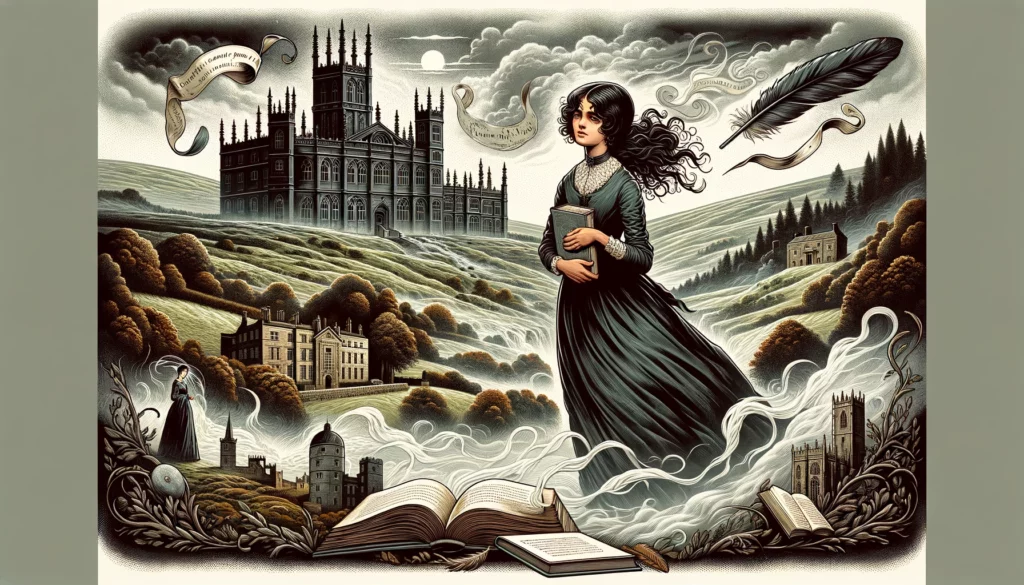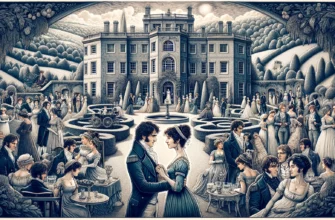The Foundations of “Jane Eyre”
Charlotte Brontë, born on April 21, 1816, in Thornton, West Yorkshire, was the third of six children to Maria Branwell Brontë and Patrick Brontë. The moors of Yorkshire, with their bleak and untamed beauty, formed the backdrop of her childhood and later became a significant setting in her writing.
The death of her mother in 1821 and her two older sisters in 1825, marked by poverty and hardship, introduced themes of loss and resilience early in her life.
Charlotte’s education began at the Clergy Daughters School at Cowan Bridge, but the harsh conditions there, reflected in the Lowood School of “Jane Eyre,” led to her early withdrawal.
The Brontë siblings grew up in an environment rich with literature, where their father’s library offered a window to the world of words. From a young age, Charlotte and her sisters, Emily and Anne, developed a passion for writing and crafting elaborate fantasy worlds and stories.
In 1831, Charlotte continued her education at Roe Head School, where she excelled academically and later returned as a teacher from 1835 to 1838. Her experiences as a governess, first in 1839 for the Sidgwick family and later for the White family in 1841, were not fulfilling. Yet, they provided critical insights into women’s lives and Victorian England’s class structure, which she skillfully integrated into her novels.

The period of 1842 to 1844 saw Charlotte and her sister Emily studying in Brussels, Belgium, at the Pensionnat Heger. This experience broadened her cultural perspective and introduced her to the complexities of unrequited love, a theme she explored in her works, among the best classic novels.
The loss of her siblings, her brother Branwell in 1848, followed by Emily and Anne in 1849, was a period of profound grief and isolation for Charlotte. These personal sorrows deeply influenced her writing, infusing it with a depth of emotion and authenticity.
Charlotte Brontë’s Literary Journey
Charlotte Brontë’s journey into the literary world was marked by perseverance and resilience. In the early 1840s, after her return from Brussels, Charlotte, along with her sisters Emily and Anne, began to pursue a career in writing seriously seriously. Initially, they faced the challenge of breaking into a literary market that was not only competitive but also biased against female authors. Their early works, a collection of poems published in 1846 under the pseudonyms Currer, Ellis, and Acton Bell, received little attention, selling only a few copies.
Undeterred by their poetry’s lukewarm reception, Charlotte began writing “Jane Eyre”. The novel, completed in 1847, was initially met with skepticism by publishers. Her choice of the pseudonym Currer Bell was a strategic decision to navigate the gender prejudices of the time. This anonymity allowed her work to be judged by its merit rather than the gender of its author. When “Jane Eyre” was finally published by Smith, Elder & Co., it was an instant success, widely praised for its originality, depth of character, and narrative power. The novel’s success was significant in Charlotte’s life, marking her transition from a struggling writer to a respected author.
Despite its popularity, “Jane Eyre” also sparked controversy, with critics and readers speculating about Currer Bell’s true identity and autobiographical elements. The boldness of the protagonist and the novel’s critique of social norms challenged conventional expectations of women and their portrayal in literature. Charlotte’s subsequent revelation of her true identity further fueled the public’s fascination with her work, solidifying her position in the literary world.
Themes and Styles in “Jane Eyre”
“Jane Eyre” is renowned for its intricate exploration of themes such as morality, social criticism, and the struggle for independence. Charlotte Brontë, through her narrative, delves into the moral complexities faced by individuals in a society bound by strict social hierarchies and gender norms. The novel challenges the status quo by presenting an assertive, morally upright heroine ready to forge her path in life.
One of the novel’s central themes is the critique of social class structures and the hardships faced by those at the lower rungs of society. Jane’s experiences at Lowood School and subsequent roles as a governess provide a scathing commentary on the limited opportunities and harsh treatment of women, particularly those without wealth or connections. Charlotte’s own experiences as a governess and her acute observation of the class dynamics of her time lend authenticity to these portrayals.
Another dominant theme in the novel is the struggle for independence and self-respect. Jane Eyre’s journey from a dependent orphan to a self-assured, independent woman is a powerful narrative of personal growth and self-discovery. The novel’s portrayal of Jane’s inner thoughts and feelings, particularly her moral reflections and her desire for love that does not compromise her dignity, was groundbreaking.
Charlotte Brontë’s narrative style, especially her use of the first-person perspective, allows readers a direct insight into Jane’s thoughts and emotions, creating a deep sense of intimacy and empathy. This innovative approach was instrumental in the novel’s success, offering a new level of psychological depth and realism in character development. The blend of gothic elements, romanticism, and realism in “Jane Eyre” makes it a compelling read and a significant work in the history of English literature.
Character Analysis and Development
The character development in “Jane Eyre” is a testament to Charlotte Brontë‘s profound understanding of human psychology and social dynamics. Jane herself is portrayed as a figure of resilience and moral fortitude. Her growth from a rebellious orphan at Gateshead to an honest, strong-willed woman is central to the narrative. This evolution reflects her inner strength and refusal to compromise her self-respect and moral values despite her challenges.
Edward Rochester, the enigmatic master of Thornfield Hall, is another character of great complexity. His tumultuous relationship with Jane marks a balance of power and vulnerability. Rochester challenges the conventional male hero trope of Victorian novels. His moral ambiguity and intense emotional depth make him a character that enthralls and perplexes the reader.
The novel also presents a rich tapestry of secondary characters, each contributing to the story’s social commentary. Characters like St. John Rivers, with his rigid morality and missionary zeal, and Bertha Mason, the “madwoman in the attic,” symbolize the broader societal issues of the era, such as colonialism, mental health, and the constraints placed on women.
The development of these characters and their interactions with Jane are pivotal in highlighting the social and gender norms of the Victorian era. Through her characters, Brontë explores themes of independence, morality, and the quest for a meaningful existence, making “Jane Eyre” a novel of deep psychological and social insight.
“Jane Eyre” in the Context of Victorian Literature
“Jane Eyre” is distinctive in Victorian literature, marked by its innovative narrative style and profound thematic depth. The novel was a departure from the conventional literature of the time, which often portrayed women in submissive, ornamental roles. As a character, Jane Eyre boldly asserted female autonomy and moral integrity.
The novel’s exploration of themes like social class, gender relations, and personal freedom resonated with the intellectual and cultural currents of the time. It emerged during a period marked by great social and economic change, reflecting the complexities and contradictions of the Victorian age.
Comparatively, Brontë’s work differed from her contemporaries by offering a more intimate and psychological portrayal of its characters, a stark contrast to the era’s often didactic and moralizing literature. Authors like Charles Dickens and George Eliot delved into social issues and the human condition. Still, Brontë’s approach was unique in its intense focus on the individual’s inner struggle and moral autonomy.
“Jane Eyre” also contributed significantly to the evolution of the English novel. Its blend of realism, gothic elements, and strong narrative voice influenced the literary landscape of the time. The novel’s success paved the way for future generations of writers, particularly women, by challenging the accepted norms of storytelling and character development. Its enduring relevance and appeal lie in Brontë’s ability to weave complex characters and rich thematic content into a compelling narrative, making “Jane Eyre” a seminal work in the canon of English literature.
Critical Reception and Legacy
The initial reception of “Jane Eyre” was a mixture of admiration and controversy. While many praised Brontë’s narrative style and the depth of her characters, others criticized the novel for what they perceived as an overly passionate and rebellious tone, particularly in its portrayal of a female protagonist. The speculation surrounding the author’s true identity, Currer Bell, added to the novel’s mystique and public interest.
Over time, Jane Eyre has secured its status as a classic of English literature and has become the subject of extensive academic study and critique. Critics have analyzed the novel from various perspectives, including feminist, psychoanalytic, and historical, revealing the layers of complexity and meaning in Brontë’s writing.
The legacy of “Jane Eyre” extends beyond its literary achievements. The novel has been adapted numerous times for film, television, and theater, each interpretation offering a new perspective on the timeless story. These adaptations underscore the novel’s continued relevance and ability to resonate with audiences across different eras and cultures.
“Jane Eyre” Beyond the Book
“Jane Eyre” has transcended its original literary form to become a cultural and educational touchstone. The novel’s influence is evident in the works of numerous writers who have drawn inspiration from Brontë’s themes, characterizations, and narrative style. Its impact on literature is a testament to the novel’s complexity, depth, and universal appeal.
In academic circles, “Jane Eyre” is a staple of literature curricula, prompting discussions and analyses that delve into its thematic richness and historical context. The novel’s exploration of social norms, gender roles, and personal autonomy continues to spark debate and inspire new interpretations.
Furthermore, the presence of “Jane Eyre” in popular culture, through references in film, television, and other media, demonstrates its enduring significance. The novel’s exploration of human emotions, struggles, and the quest for identity continues to captivate and inspire, making “Jane Eyre” a perennial favorite and a beacon of literary achievement.







